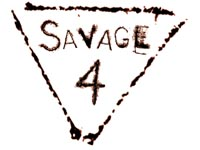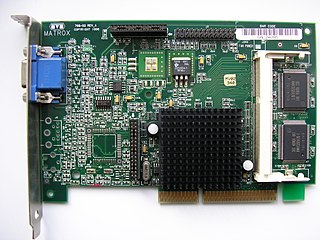
Matrox Graphics, Inc. is a producer of video card components and equipment for personal computers and workstations. Based in Dorval, Quebec, Canada, it was founded in 1976 by Lorne Trottier and Branko Matić. The name is derived from "Ma" in Matić and "Tro" in Trottier.

The GeForce 256 is the original release in Nvidia's "GeForce" product line. Announced on August 31, 1999 and released on October 11, 1999, the GeForce 256 improves on its predecessor by increasing the number of fixed pixel pipelines, offloading host geometry calculations to a hardware transform and lighting (T&L) engine, and adding hardware motion compensation for MPEG-2 video. It offered a notably large leap in 3D PC gaming performance and was the first fully Direct3D 7-compliant 3D accelerator.

ATI Technologies Inc., commonly called ATI, was a Canadian semiconductor technology corporation based in Markham, Ontario, that specialized in the development of graphics processing units and chipsets. Founded in 1985, the company listed publicly in 1993 and was acquired by AMD in 2006. As a major fabrication-less or fabless semiconductor company, ATI conducted research and development in-house and outsourced the manufacturing and assembly of its products. With the decline and eventual bankruptcy of 3dfx in 2000, ATI and its chief rival Nvidia emerged as the two dominant players in the graphics processors industry, eventually forcing other manufacturers into niche roles.

3dfx Interactive, Inc. was an American computer hardware company headquartered in San Jose, California, founded in 1994, that specialized in the manufacturing of 3D graphics processing units, and later, video cards. It was a pioneer in the field from the late 1990s to 2000.

A graphics processing unit (GPU) is a specialized electronic circuit initially designed to accelerate computer graphics and image processing. After their initial design, GPUs were found to be useful for non-graphic calculations involving embarrassingly parallel problems due to their parallel structure. Other non-graphical uses include the training of neural networks and cryptocurrency mining.

The RIVA 128, or "NV3", was a consumer graphics processing unit created in 1997 by Nvidia. It was the first to integrate 3D acceleration in addition to traditional 2D and video acceleration. Its name is an acronym for Real-time Interactive Video and Animation accelerator.

The RIVA TNT2 is a graphics processing unit manufactured by Nvidia starting in early 1999. The chip is codenamed "NV5" because it is the 5th graphics chip design by Nvidia, succeeding the RIVA TNT (NV4). RIVA is an acronym for Real-time Interactive Video and Animation accelerator. The "TNT" suffix refers to the chip's ability to work on two texels at once. Nvidia removed RIVA from the name later in the chip's lifetime.

The Voodoo 5 was the last and most powerful graphics card line that was released by 3dfx Interactive. All members of the family were based upon the VSA-100 graphics processor. Only the single-chip Voodoo 4 4500 and dual-chip Voodoo 5 5500 made it to market.
Glide is a 3D graphics API developed by 3dfx Interactive for their Voodoo Graphics 3D accelerator cards. It started as a proprietary API, and was later open sourced by 3dfx. It was dedicated to rendering performance, supporting geometry and texture mapping primarily, in data formats identical to those used internally in their cards. Wide adoption of 3Dfx led to Glide being extensively used in the late 1990s, but further refinement of Microsoft's Direct3D and the appearance of full OpenGL implementations from other graphics card vendors, in addition to growing diversity in 3D hardware, eventually caused it to become superfluous.

Savage was a product-line of PC graphics chipsets designed by S3.

Diamond Multimedia is an American company that specializes in many forms of multimedia technology. They have produced graphics cards, motherboards, modems, sound cards and MP3 players; however, the company began with the production of the TrackStar, a PC add-on card which emulated Apple II computers. They were one of the major players in the 2D and early 3D graphics card competition throughout the 1990s and early 2000s.

Rendition, Inc., was a maker of 3D computer graphics chipsets in the mid to late 1990s. They were known for products such as the Vérité 1000 and Vérité 2x00 and for being one of the first 3D chipset makers to directly work with Quake developer John Carmack to make a hardware-accelerated version of the game (vQuake). Rendition's major competitor at the time was 3Dfx. Their proprietary rendering APIs were Speedy3D and RRedline.
The Intel Graphics Media Accelerator (GMA) is a series of integrated graphics processors introduced in 2004 by Intel, replacing the earlier Intel Extreme Graphics series and being succeeded by the Intel HD and Iris Graphics series.

The ATI Rage is a series of graphics chipsets developed by ATI Technologies offering graphical user interface (GUI) 2D acceleration, video acceleration, and 3D acceleration developed by ATI Technologies. It is the successor to the ATI Mach series of 2D accelerators.
The G400 is a video card made by Matrox, released in September 1999. The graphics processor contains a 2D GUI, video, and Direct3D 6.0 3D accelerator. Codenamed "Toucan", it was a more powerful and refined version of its predecessor, the G200.

Voodoo3 was a series of computer gaming video cards manufactured and designed by 3dfx Interactive. It was the successor to the company's high-end Voodoo2 line and was based heavily upon the older Voodoo Banshee product. Voodoo3 was announced at COMDEX '98 and arrived on store shelves in early 1999. The Voodoo3 line was the first product manufactured by the combined STB Systems and 3dfx.

The G200 is a 2D, 3D, and video accelerator chip for personal computers designed by Matrox. It was released in 1998.
Transform, clipping, and lighting is a term used in computer graphics.

The Voodoo2 is a set of three specialized 3D graphics chips on a single chipset setup, made by 3dfx. It was released in February 1998 as a replacement for the original Voodoo Graphics chipset. The card runs at a chipset clock rate of 90 MHz and uses 100 MHz EDO DRAM, and is available for the PCI interface. The Voodoo2 comes in two models, one with 8 MB RAM and one with 12 MB RAM. The 8 MB card has 2 MB of memory per texture mapping unit (TMU) vs. 4 MB on the 12 MB model. The 4 MB framebuffer on both cards support a maximum screen resolution of 800 × 600, while the increased texture memory on the 12 MB card allows more detailed textures. Some boards with 8 MB can be upgraded to 12 MB with an additional daughter board.
Fahrenheit is the codename for a GPU microarchitecture developed by Nvidia, and released in 1998, as the successor to STG-2000, Riva 128 microarchitecture. It was named with reference to Fahrenheit and used with STG-2000, Riva 128.




















